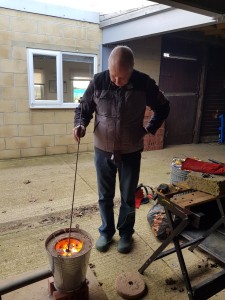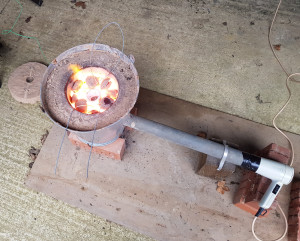Investment casting, or the lost-wax process, is one of humanity’s oldest technologies. A wax master model is made, and repeatedly dunked in liquid clay slip then dried. Each dunk adds a few millimetres of clay until the wax master is completely encased in a solid clay surround. The result is fired in a kiln, which melts then burns out the wax, leaving a perfect clay mould. Into that molten metal is poured to create a metal version of the wax original.
Instead of a wax model, one can use a PLA 3D print. As long as natural PLA with no additives is used it too burns out completely from the clay mould on firing.
We have started experiments with an aluminium foundry. It’s made from an old bucket into which we poured plaster and sand, with a plastic flower-pot in the middle to make a dent for the fire. (We know that plaster and sand is not an ideal refractory material, but it’s what we had.) At the side is a steel tube for the air blower, which is an old hair dryer. The tube leads into the bottom of the flower-pot hole.
As our first experiment we melted 100g of old drink cans, crushed so they would fit in a crucible we got from Ebay. At this stage we just wanted to check that we could melt the aluminium reliably.
Next we’ll do a print then cast it in aluminium…
Connect with us
Keep up to date on the latest RepRap Ltd news:




Impressed!! Looking for forard to next steps…
You can also use 3D printing for conventional casting in sand. I can also recommend using old disk drive cases instead of cans for a better quality of casting metal.
Yes – I’ve done sand casting from polystyrene foam patterns, but not 3D prints. Like the disc casing idea; we have a stack somewhere…